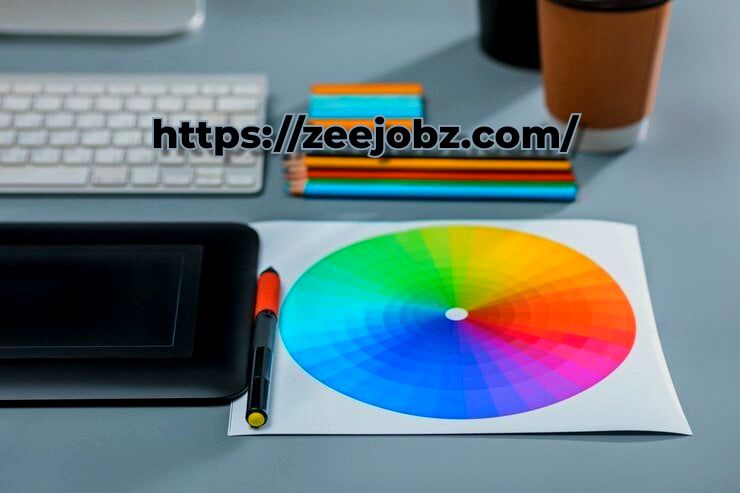Introduction to color theory
Color theory idea is a fundamental issue of format and paintings that includes the standards and guidelines that artists and designers use to create visually appealing compositions. This concept delves into how colors work, the intellectual results they produce, and the harmonious combos that can be achieved. In this complete article, we can discover the essence of the concept of coloring, its ancient history, key ideas, and practical applications in various fields. Thanks to the color principle of expertise, people can decorate their innovative duties, communicate more successfully, and evoke the desired emotional responses.
The Essence of Color Theory
A color theory is a look at the way colors interact and the effects they create even when they are mixed. It offers a framework for expert knowledge of the relationships between colors and how they will be used to create aesthetically appealing and harmonious designs. The color principle is at its core an image and a generation, mixing the innovative instinct of artists with the empirical observations of scientists.
The basic elements of the color principle embody the color circle, color harmony, and the mental impact of colors. By studying the elements of one, people could create informed alternatives approximately color mixtures and their applications in different contexts.
Historical background of color theory

The origins of the principle of coloring can be traced back to ancient civilizations when students and artists began to investigate the nature of colors. However, he turned into Sir Isaac Newton, who laid the muse on the modern color theory principle in the seventeenth century. Newton’s experiments with diminutives and prisms led to the invention of the hue spectrum, which revealed that white light is composed of many hues.
In the 18th century, Johann Wolfgang von Goethe expanded on Newton’s paintings and emphasized the mental results of color. Goethe’s “Theory of Color” explored how colors affect emotion and perception, laying the foundation for the intellectual elements of color perception.
In the course of the nineteenth and twentieth centuries, artists together with Wassily Kandinsky and Josef Albers developed the principle of coloring and researched the relationships between colors and their influence on the visual image. Their contributions shaped the principle of dyeing today, making it a vital tool for artists, designers, and marketers.
The color theory: an essential tool
A shade wheel is a circular diagram that represents the relationships between shades. It is an important device in the color concept that helps people understand how colors work together and complement each difference. The color wheel consists of three number-one hues (purple, blue, and yellow), three secondary colors (inexperienced, orange, and purple), and 6 tertiary colors (a mixture of number-one and secondary colors).
Primary colors
The primary shades are the inspiration for the color theory. They cannot be created by mixing different colors and act as building blocks for all exceptional colors. The number one colors are crimson, blue, and yellow.
Secondary colors
Secondary colors are the original mixing of primary shades. The secondary colors are green (blue and yellow), orange (red and yellow), and red (red and blue).
Tertiary colors
Tertiary colors are created by mixing color number one with an adjacent secondary color. Examples of tertiary coloration include purplish-orange, yellow-green, and blue-violet.
Color theory: Creating balanced compositions
Color harmony refers to an aesthetically pleasing collection of colors. It is a basic detail of the color code that guides artists and designers in cultivating balanced and visually attractive compositions. There are many color schemes, each creating unique results and moods.
Complementary colors
Complementary shades are opposite on the color wheel. When used together, they come up with an excessive rating and colorful look. Examples of complementary color pairs include purple and green, blue and orange, and yellow and red.
Analogous colors
Analogous colorings follow one another on the color wheel. They create harmonious and peaceful patterns because they share an unusual hue. An instance of the same color scheme is blue, teal, and inexperienced.
Triadic colors
Triadic color schemes use 3 colors that are evenly spaced throughout the color wheel. This scheme provides a balanced and vibrant look, with each color complementing the others. An example of a triadic color scheme is red, blue, and yellow.
Split-complementary colors
Split complementary color schemes include one primary color and adjacent complementary hues. This scheme offers a moderate rating without being as intense as a complementary color scheme. For example, a chopped complementary scheme should include blue, yellow-orange, and pink-orange.
Tetradic colors
Tetradic (or doubly complementary) color schemes use 4 hues arranged in complementary pairs. This scheme offers a rich and varied palette but can be difficult to balance. An example of a tetradic color scheme is blue, orange, pink, and green.
Monochromatic colors
Monochromatic color schemes use special sunglasses, shades, and tones of free color. This scheme creates a cohesive and harmonious look, specializing in variations of an interior single shade. An example of a monochromatic scheme is numerous shades of blue.
The psychological impact of color theory
Colors have a profound effect on human emotions and perceptions. Understanding the mental implications of color is a key factor in a color concept that allows individuals to evoke specific responses and create a favorite atmosphere.
Red
Red is a strong and vibrant color, often associated with passion, pride, and urgency. It can stimulate food cravings and coronary heart price growth, making it a famous choice for restaurants and commercials.
Blue
Blue is a cool and simple color, often associated with stability, calm and reliability. It is commonly used in corporate branding and healthcare to evoke an experience of professionalism and security.
Yellow
Yellow is a happy and uplifting color associated with happiness, optimism, and warmth. It can attract attention and arouse enthusiasm, so it is suitable for advertising and promotional materials.
Green
Green is a refreshing and herbal color, symbolizing prosperity, harmony, and health. It is regularly used in designs related to the environment and well-being to bring a sense of stability and rejuvenation.
Purple
Purple is an expensive and mysterious color that is often associated with creativity, spirituality, and sophistication. It can create a sense of beauty and intrigue, which makes it a favorite of lust for splendor and over-indulgence manufacturers.
orange
Orange is an active and enthusiastic color, combining the warmth of crimson and cheerful yellow. It is regularly used to create an experience of pleasure and stimulation, making it suitable for sports and fitness designs.
Black
Black is a strong and fashionable color that is regularly associated with sophistication, authority, and ritual. He can create the joy of thriller and drama, which makes him famous desire for expensive brands and formal events.
White
White is a smooth and pure color that symbolizes simplicity, innocence, and clarity. It is often used in minimalist designs and healthcare facilities to create a sense of openness and freshness.
Practical applications of color theory

Graphic design
In image layout, the principle of hue is essential to creating visually appealing and effective designs. Designers use the principles of shade matching to select shade palettes that improve readability, carry the right message, and evoke the desired emotional response. Understanding the mental impact of color allows designers to create designs that resonate with their target audience.
Interior design
Interior designers use the concept of shadows to create harmonious and pleasant areas. Based on information about how colors interact and affect feelings, designers can choose color schemes that enhance the mood and capabilities of a room. For example, calming shades like blue and green are often used in bedrooms, while energetic colors like purple and orange are used in living rooms and kitchens.
Fashion design
In terms of style format, the idea of shadow helps designers create cohesive and elegant collections. By understanding color theory and the mental impact of color, designers can create clothing that expresses a favorite mood and complements gorgeous pores and skin tones. For example, a fashion designer can also use a monochromatic color scheme to create an elaborate and stylish look.
Marketing and branding
Logo marketers and strategists use the concept of coloring to create a strong logo identity and effective advertising campaigns. By knowing the intellectual effect of color, they were able to select colors that resonated with their target market and delivered the desired emblem message. For example, a logo that wants to inspire faith and trust may also use the color blue in its branding and advertising, marketing, and promotional materials.
Art
Artists use the idea of hues to create visually compelling and emotionally powerful works of art. Based on information about the relationships between colors and their effects on emotions, artists can create compositions that convey specific moods and messages. For example, an artist can also use complementary colors to create a colorful and dynamic painting, or analogous colors to create a harmonious and peaceful landscape.
Exploring the depths of color theory
The Color Principle is a comprehensive framework that discloses the use and aggregation of color in art and format. It combines the medical expertise of light and human perception with the innovative practice of creating visible compliance. The basic elements of the idea of color, including the hue wheel, color matching, and the mental effect of color, provide important equipment for artists, designers, and all entities involved in visual communication. Understanding these ideas allows for more intentional and effective use of color, enhancing every aesthetic appeal and emotional impact.
The color wheel: an essential tool
The coronary heart of the shadow concept is the color wheel, a circular diagram representing the relationships between solar hues. The color wheel is divided into number one, secondary, and tertiary shades. The primary sunglasses (red, blue, and yellow) are the building blocks from which all exclusive colors are derived. The secondary colors (inexperienced, orange, and red) are normal due to the number one shade mixing. Tertiary colors are created by mixing color number one with an adjacent secondary color. This method allows you to get information about how colors interact and mix, making it less difficult to create harmonious color schemes.
Color theory: Creating visual balance
Color harmony refers back to an aesthetically appropriate sum of colors. There are several color harmony schemes, each generating different effects and moods. Complementary sunglasses that are unique on the color wheel unlike any other create an exaggerated assessment and colorful appearance. Analogous colors that can follow each other provide a calm and cohesive arrangement. Triadic color schemes, the use of 3 calmly spaced shades, offer a balanced and dynamic palette. These schemes of harmony guide artists and architects in choosing color mixtures that achieve the desired visual effects and emotional responses.
Application of color theory in various fields

The color principle is elaborated extensively in many areas consisting of image design, interior format, fashion, advertising and marketing and marketing and high-quality art. In graphic design, it helps in the development of visually impressive websites and advertisements. Interior designers use color theory to create areas that evoke unique moods, along with soothing bedrooms or energetic living rooms. Fashion designers rely on it to develop cohesive collections that attract customers. Marketers use the concept of coloring to create identities and emblem campaigns that resonate with their audience. Artists hire her to create paintings and installations that express their intended emotions and stories.
Evolution of color theory
Hue control has evolved greatly over the centuries. Early theories with a useful source of figures, together with Aristotle and Leonardo da Vinci, focused on the character of the shadow itself. In the 17th century, Sir Isaac Newton’s experiments with moderates and prisms discovered the color spectrum, which laid the foundation for the current concept of hues. Additionally, in the 18th and 19th centuries, Johann Wolfgang von Goethe and artists such as Wassily Kandinsky and Josef Albers asserted the intellectual and perceptual factors of the shadow. Today, hue theory is constantly adapting, incorporating insights from psychology, neurology, and the virtual generation to embellish our information about colors and their packaging.
Conclusion: The Enduring Importance of Color Theory
The color idea continues to be an important detail of visual art and format, providing vital equipment and ideas for cultivating harmonious and impressive compositions. Its programs go beyond conventional artwork and influence fields that include marketing, interior design, and digital media. Through the information and application of the requirements of the color idea, people can embellish their revolutionary tasks, speak extra correctly, and generate the desired emotional responses.
As our facts about hue continue to expand, the ideas of the concept of coloring will remain the cornerstone of powerful and meaningful visual communication. A color code is an effective device that allows people to create visually appealing and emotionally impactful designs. Using data, hue harmony standards, and intellectual color effects, artists, designers, and marketers can beautify their progressive tasks and effectively convey their messages. Whether you’re designing a website, decorating a home, creating a fashion collection, or developing an advertising and marketing advertising marketing campaign, the color code offers the foundation for an informed and impactful shade selection.
FAQ
What is a shadow idea?
A color concept is a study of the methods that hues involve and the results they create when mixed. It advises on developing visually appealing and harmonious compositions.
What are the number one colors?
The number one sun shades are red, blue, and yellow. They act as building blocks for all different colorations and cannot be created by mixing extraordinary colors.
What is a color wheel?
A color wheel is a circular diagram that represents the relationships between colors. Composed of primary, secondary, and tertiary hues, it allows people to understand how colors interact and complement each specialty.
What is color harmony?
Color harmony means an aesthetically appealing collection of colors. It publishes artists and architects creating balanced and visually appealing compositions.
How do shades affect emotions?
Colors have a profound effect on human feelings and perceptions. For example, red can evoke passion and delight, while blue can evoke a sense of calm and memories.
How is the coloring idea used in the layout of the picture?
In photo layout, the concept of shadow is used to create visually appealing and powerful designs. Designers use the principles of color matching and the psychological impact of color to choose color palettes that adorn clarity and convey the right message.
How is color theory reflected in interior design?
Interior designers use the concept of shadows to create harmonious and pleasant areas. With the know-how of how colors interact and affect feelings, designers can choose color schemes that enhance the mood and capabilities of a room.
Read More: The ://vital-mag.net blog: Unleashing the Power of Quality Content



